Thanks to the people who have contributed to this week’s newsletter: Connie Cao, Julie Merlet, Melissa la Porte and Pam Jenkins.
Davidson plum (Davidsonia genus) by Julie Merlet
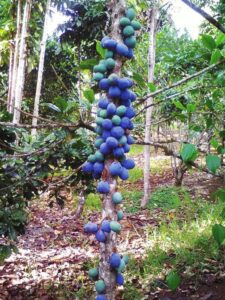 [The material below is a shortened version of material from the NATIF website which was written by newsletter reader Julie Merlet. NATIF (which is an acronym for N=Native, A=Australian, T=Traditional, I=Indigenous and F=Foods) sell a wide range bush food products online (including davidson plum powder and davidson plum and rivermint tea).]
[The material below is a shortened version of material from the NATIF website which was written by newsletter reader Julie Merlet. NATIF (which is an acronym for N=Native, A=Australian, T=Traditional, I=Indigenous and F=Foods) sell a wide range bush food products online (including davidson plum powder and davidson plum and rivermint tea).]
The three trees in the Davidsonia genus are all called davidson plums and all have edible fruit. They grow in tropical north-east Queensland and northern NSW.
The fruit is dark blue/purple on the outside and reddish-pink flesh on the inside. It has a sour taste with an aroma that, depending on species, has been likened to either beetroot (Davidsonia jerseyana) or stewed rhubarb (Davidsonia pruriens) .
The sourness can be balanced out when mixed with your favourite juice, smoothie or dessert. And, because it is low in sugar, it can be used in jams or sauces.
The fruit is a good source of antioxidants, including vitamin E, anthocyanin and lutein. It also has high levels of zinc, calcium and potassium. It has low levels of sugar.
Your Asian veggie patch
Connie Cao’s new book, Your Asian veggie patch, was launched at Bulleen Art & Garden (BAAG) nursery last week. There were book signings (you chose the colour of pen for Connie to use and I chose green), a Q&A session, free food (my favourite was kuih dada, which was a rolled crepe filled with grated coconut and flavoured with various juices) and some competitions (my wife won some snake bean seeds).
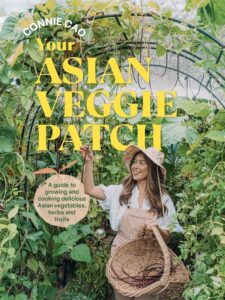
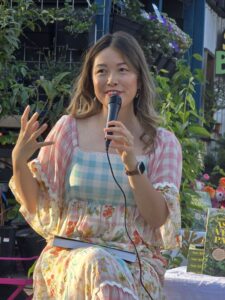
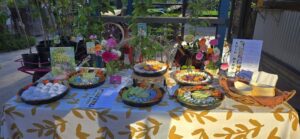
You can buy the book online from (as they say) all good retailers.
Chilli (by Connie Cao)
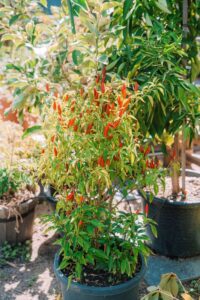 [To celebrate her new book, Your Asian veggie patch, Connie has been providing some material for this newsletter about some of her favourite Asian veggies that you can grow during the summer. This week’s subject is chilli and is the last in the series for the time being. You can read her previous veggie contributions on our website.]
[To celebrate her new book, Your Asian veggie patch, Connie has been providing some material for this newsletter about some of her favourite Asian veggies that you can grow during the summer. This week’s subject is chilli and is the last in the series for the time being. You can read her previous veggie contributions on our website.]
Chilli is a prominent ingredient in many Asian cuisines. Places such as Southeast Asia, Korea and Sichuan and Hunan provinces in China (just to name a few) love to add a bit of heat to their dishes.
The plants are compact and happily grow in pots, so are highly suited to small spaces. I grow all my chillies in pots so I can save my garden space for other plants. A 30-40cm wide pot is best. I like to grow my chillies with a western aspect, as they thrive in the heat. My best container grown chillies have given me more than 100 fruits per season!
Watch this video on Instagram, where I make two additional points:
- Grow chillies in full sun.
- Be patient – chillies sit green on the plant for ages and usually don’t ripen until near the end of summer.
[Editor: although most people grow chilli plants as annuals, they are actually short lived perennials if not killed by frost. If you grow your chilli plants in pots, you can move them during winter to somewhere protected from the frost, such as a greenhouse or indoors, and they will come back to life the following spring.]
Naturli’ Organic Spreadable is back!
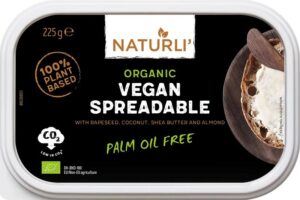 It is certainly not the purpose of this newsletter to try and influence what foods you should buy but occasionally, very occasionally, I come across a food that is so good that I feel that I should tell as many people as possible about it. This is such a rare event that it has actually only ever happened to me once, namely today!
It is certainly not the purpose of this newsletter to try and influence what foods you should buy but occasionally, very occasionally, I come across a food that is so good that I feel that I should tell as many people as possible about it. This is such a rare event that it has actually only ever happened to me once, namely today!
After a long hiatus, Naturli’ Organic Spreadable is back in Australia! It is a vegan alternative to butter and is made from rapeseed, coconut oil, shea butter and almond butter. It tastes really yum, without the yuckiness that an excess of butter can sometimes have. It spreads really well, even straight out of the fridge. And it lasts forever if stored in the fridge. If you have ever had it, then you already know all this but if you have never had it, then go get it and treat yourself!
I buy my Naturli’ Organic Spreadable from Organic Fix in Eltham. Apples and Sage Organic Wholefoods in Balwyn also sell it. And their website says that it is available at selected IGA stores.
Some more new articles from Angelo Eliades
Garden cress growing guide.
The essential guide to chill hours for growing currants and gooseberries.
Read more of Angelo’s articles about food growing.
Do you know?
Michelle asks: “I have garlic planted at the base of my orange tree and it’s growing nicely, will be ready in summer. How can I fertilise the orange tree for Spring without affecting my garlic?” Email me with your thoughts.
10 years of the Now and Not Yet Cafe
The Now and Not Yet Cafe in Warrandyte has a unique ambience. To celebrate its 10th birthday, the Warrandyte Diary recently interviewed its owner, Derek Bradshaw.
Critter of the week from my garden – caper white butterfly
The two photos are of a caper white butterfly (Belenois java in family Pieridae) in the garden of Pam Jenkins. As you can see from Pam’s photos, the upper (dorsal) and lower (ventral) surfaces of the wings are differently coloured, with the upper surface being white with a black border (see left hand photo) and the lower surface being patches of white, yellow and black (see right hand photo). Pam says that the butterfly was attracted to the blue flowers of her coastal rosemary (Westringia fruticosa).


The caterpillars feed exclusively on caper bushes (genus Capparis), hence the common name. They are presumably viewed by caper growers in the same way that we brassica growers regard the cabbage white butterflies.
The butterfly mainly lives in inland southern Queensland and northern NSW but is migratory. They can sometimes be blown off course during their migration and end up as far south as Melbourne, hence its presence in Pam’s garden.
According to the Australian Museum website, this species regularly migrates to areas where there are no food plants for its caterpillars. “It is not understood why this behaviour has evolved.”
On the subject of butterflies whose upper and lower surfaces are different, here are some photos of an orange oakleaf butterfly (Kallima inachus) that once landed on my hand. Its upper surface was relatively normal, albeit a bright mixture of blue and orange, but its lower surface (which I could see whenever it closed its wings) looked just like a dry leaf!
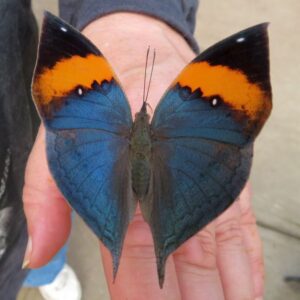
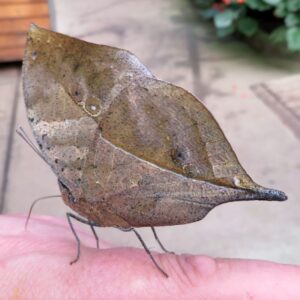
Thanks to Pam for sending in this week’s photos. If you have any interesting photos of critters in your garden, email them to me.
Read about my previous insects (or other critters) of the week on our website.
The Melbourne ‘Local Food Connections’ community radio show
On next Sunday’s show (20th October, 10-10.30am) on 3CR (855 AM), Ann and Amy will continue to interview permie elders John and Mal. Listen by tuning into either the station (855 AM) or its livestream.
Podcasts of all previous episodes are available on their website, the latest being
Jessica from Breadline on anti-glyphosate campaigning.
Which link was clicked most times in the last newsletter?
The most popular link in the last newsletter was EML ART Cookies’ online shop.
The most popular event link in the last newsletter was the upcoming veggie seedling propagation workshop by Caring Farms Coop in St Helena on 14th November.
Regular activities over the coming week
Farmers’ and other food markets
Food swaps
Community gardens
- Thursday: Buna (Heidelberg West), Diamond Valley Library (Greensborough), Edible Hub (Hurstbridge), Fawkner (playgroup – need to book), SEEDs (Brunswick) and Whittlesea.
- Friday: Panton Hill and West Brunswick.
- Saturday: Glen Park Oaks (Bayswater North), Links (Lalor), Macleod, Radicle Roots (Coburg) and Thrive (Diamond Creek).
- Sunday: Bellfield, Croxton / Marra Guwiyap (Northcote), Fawkner Food Bowls and Regent (Reservoir).
- Monday: SEEDs (Brunswick) and Whittlesea.
- Tuesday: Doncaster Hill and Watsonia.
- Next Wednesday: Eltham Neighbourhood House, Macleod, Newton Street (Reservoir), Sylvester Hive (Preston) and Span (Thornbury).
Not (quite) local but interesting
The festival will include food & other market stalls, live music, guest speakers and plant sales. At Mulberry Community Garden, 120 Glenroy Road, Glenroy.
Neither food-related nor local but interesting
Enjoy a large array of cacti and succulent plants, displays, the Cactus and Succulent Society of Australia (CSSA) members’ specimen competition and Victoria’s largest gathering of sellers and growers. At KCC Park (State Dog Centre), 655 Western Port Highway, Skye.
Upcoming face-to-face events – not cooking
Sake master class; Sunday, 3rd November, midday-2pm; $73 ($37 per hour); Brunswick East.
Kana Aoyama will guide you through the history, production and tasting of this traditional Japanese beverage. She will teach you all the basics, let you try 5 different styles, and show you how to pair sake with cheese, cured meats and chocolate.
FareShare kitchen garden open day; Saturday, 23rd November, 10am-3pm; small donation requested; Abbotsford.
Get a guided tour of their farm. They grow around 6,000Kg of herbs and vegetables each year at the Abbotsford farm to support meal production in their nearby kitchen. Read about FareShare.
In October
- Growing food at home (10 sessions); on consecutive Thursdays, starting 17th October, 9.30am-1.30pm; $154 ($4 per hour); Heidelberg West.
- Edible weeds; Saturday, 19th October, 10am-midday; $70 ($35 per hour); CERES.
- U-pick broad beans; Saturday, 19th October, 10am-midday; $11; Coburg.
- Living a permaculture life; on Saturday, 19th October, 11am-12.30pm; $10; Research.
- Open Cellars of Nillumbik; Saturday, 19th October, 11am-5pm; free; various locations.
- Living a permaculture life; on Saturday, 19th October at 1.30-3pm; $10; Research.
- DIVRS’s Urban Food Program 10th birthday celebration; Saturday, 19th October, 1.30-4pm; free; Alphington.
- Children’s mini food fair; Sunday, 20th October, 10am-2pm; free; Edendale.
- Traditional wooden spoon carving; Sunday, 20th October, 10am-4pm; $145 ($29 per hour); CERES.
- Open Cellars of Nillumbik; Sunday, 20th October, 11am-5pm; free; various locations.
- Sake master class; Sunday, 20th October, midday-2pm; $73 ($37 per hour); Brunswick East.
- Growing your own – for kids; Tuesday, 22nd October, 4-5pm; free; Edendale.
- Care of backyard chickens; Thursday, 24th October, 11am-midday; free; Greensborough.
- Backyard biochar workshop; Saturday, 26th October, 10am-midday; free; Richmond.
- U-pick broad beans; Saturday, 26th October, 10am-midday; $11; Coburg.
- CERES Festival of fava; Saturday, 26th October, 10am-1pm; free; Coburg.
- Design your own garden; Saturday, 26th October, 10am-3pm; $145 ($29 per hour); CERES.
- Paddock to plate mushrooms at home; Saturday, 26th October, 10.30am-2pm; $250 ($71 per hour); Alphington.
- Ceramic cake stand; Sunday, 27th October, 10.30am-12.30pm; $65 ($33 per hour); Box Hill.
- Nutrition for seniors; Monday, 28th October, 1.30-2.30pm; $6; Balwyn North.
- Wildcrafting foraging course (5 sessions); on 5 consecutive Thursdays from 31st October, 6-7.30pm; $339 ($45 per hour); Coburg.
In November
- The Whittlesea Show; Saturday, 2nd November, 9am-5pm; $26; Whittlesea.
- U-pick broad beans; Saturday, 2nd November, 10am-midday; $11; Coburg.
- Farm Raiser tour and working bee; Saturday, 2nd November, 10am-2pm; free; Bellfield.
- Composting and mini market; Saturday, 2nd November, 10.30am-12.30pm; free; Montrose.
- The Whittlesea Show; Sunday, 3rd November, 9am-5pm; $26; Whittlesea.
- Sake master class; Sunday, 3rd November, midday-2pm; $73 ($37 per hour); Brunswick East.
- Getting ready for the summer harvest (part 1); Wednesday, 6th November, 7-9pm; free; Doncaster.
- Introduction to beekeeping (8 sessions); on consecutive Thursdays, starting 7th November, 6.30-9pm; $395 ($20 per hour); Fairfield.
- Herb gardens; Friday, 8th November, 10.30am-12.30pm; $25 ($13 per hour); Kinglake.
- Plant guilds, companion planting and polycultures workshop; Saturday, 9th November, 10am-midday; free; Richmond.
- Waterwise wicking beds; Saturday, 9th November, 10am-12.30pm; $20; Edendale.
- Introduction to permaculture; Saturday, 9th November, 10am-3pm; $145 ($29 per hour); CERES.
- Whisky Abbey Festival; Saturday, 9th November, 10am-7pm; $61; Abbotsford.
- Edible weeds walk; Saturday, 9th November, 10.30am-12.30pm; $30 ($15 per hour); Coburg.
- Backyard beekeeping basics; Saturday, 9th November, 11am-1pm; $80 ($40 per hour); CERES.
- Whisky Abbey Festival; Sunday, 10th November, 10am-6pm; $61; Abbotsford.
- Introduction to food photography; Sunday, 10th November, 1.30-4.30pm; $119 ($40 per hour); Warrandyte.
- Public housing community gardens; Tuesday, 12th November, 10-11am; free; Richmond.
- Public housing community gardens; Tuesday, 12th November, 11am-midday; free; Richmond.
- Bundoora Urban Agriculture Centre and Community Hub pre-launch site tour; Wednesday, 13th November, 3-4pm; free; Bundoora.
- Veggie seedling propagation workshop – Caring Farms Coop; Thursday, 14th November, 6-7.30pm; free; Greensborough.
- Bundoora Urban Agriculture Centre and Community Hub pre-launch site tour; Saturday, 16th November, 10-11am; free; Bundoora.
- Composting workshop and garden tour (Bellfield); Saturday, 16th November, 10-midday; free; Bellfield.
- Celebration and showcase of the City of Whittlesea sustainable communities workshop series; Saturday, 16th November, midday-2pm; free; South Morang.
- Eltham Wine Show; Sunday, 17th November, 10.30am-2.30pm; $20; Bulleen.
- Bundoora Urban Agriculture Centre and Community Hub pre-launch site tour; Wednesday, 20th November, 3-4pm; free; Bundoora.
- Low-waste celebrations with The Urban Nanna; Thursday, 21st November, 6.30-8pm; free; Preston.
- What is the future of urban agriculture in Naarm?; Thursday, 21st November, 6.30-8pm; free; Fitzroy North.
- Bundoora Urban Agriculture Centre and Community Hub pre-launch site tour; Saturday, 23rd November, 10-11am; free; Bundoora.
- Good & bad bugs, pests, snails & slugs and how to control them; Saturday, 23rd November, 10-midday; free; Bellfield.
- Beeswax wraps; Saturday, 23rd November, 10am-midday; $80 ($40 per hour); CERES.
- FareShare kitchen garden open day; Saturday, 23rd November, 10am-3pm; small donation requested; Abbotsford.
- Small space gardening; Saturday, 23rd November, 10am-3pm; $115 ($23 per hour); CERES.
- Beginners backyard beekeeping; Sunday, 24th November, 10am-3pm; $220 ($44 per hour); CERES.
- In-depth mushroom cultivation workshop; Sunday, 24th November, 10am-4pm; $161 ($27 per hour); Alphington.
- Italian cheese and wine masterclass; Saturday, 30th November, 2-5pm; $135 ($45 per hour); Thomastown.
In December
Regular events
- Beekeeping (Bee Sustainable); roughly once a month on Saturdays, 1-4pm; $95 ($32 per hour); Brunswick East.
- Best of Little Italy dinner tour (Flavourhood Tours); Fridays, 5-7pm; $139 ($70 per hour); Carlton.
- Brewery tour (Carlton Brewhouse); every Wednesday, Thursday and Friday, 3-4.30pm; $38 ($26 per hour); Abbotsford.
- Chocolate factory tour (Ratio Cocoa Roasters); Various Fridays and Saturdays; $20 ($20 per hour); Brunswick.
- Cocktail making (Brogan’s Way Distillery); various dates, times and costs; Richmond.
- Eltham walking food tour; various Saturday mornings and Thursday evenings; $65 ($22 per hour); Eltham.
- Melbourne’s ‘insiders’ brunch tour (Flavourhood Tours); 2nd Saturday of the month, 10am-midday; $69 ($35 per hour); Coburg.
- Food forest tour (Edible Forest); Fridays and Saturdays, 11am-1pm and 1-3pm; $28 ($14 per hour); Dixons Creek.
- Gin making (Puss and Mew); Saturdays and Sundays; $175 ($58 per hour); Nunawading.
- Gin making or tasting (Naught Distilling); Saturdays, various times and prices; Eltham.
- Plant to harvest (Sustainable Macleod); 1st Saturday of the month, midday-1pm; $5; Macleod.
- Wine tasting (FoodSocial); various Thursdays, 6-7.30pm; $33 ($22 per hour); Carlton.
- Wine tasting (Good Booze. Blind); various Saturdays and Sundays; $130 ($65 per hour); Fitzroy.
- Wine tasting (Northside Wines); various days, times and prices; Northcote.
Upcoming face-to-face events – cooking
Make a home-brew of sake, a traditional drink using koji, which they will also show in its stages. Take home a jar ready to mash into doburoku, koji to make some amazake, and koji spores to make your own koji at home.
Halloween tea blending workshop; Thursday, 31st October, 6-7.30pm; $65 ($44 per hour); Brunswick East.
You will be given a quick history of tea and a tea tasting of some of the most unique teas from around the world. Learn about the intricacies of creating balanced tea blends from various types of teas, herbs, flowers and spices. You will then make a personalised tea blend to take home. Presenter: Amy Freund, from Crafternoon Tea.
Sourdough bread workshop; Saturday, 23rd November, 10am-1pm; $55 ($18 per hour); Panton Hill.
Learn about starters and sourdough. Make a pizza base, cook a pizza with homemade toppings and eat together in class. Make a bread dough to take home to bake the next day. Take an apron, tea towel and large sealable container. Presenter: John. Organised by Living & Learning Nillumbik.
Make Christmas cookies, cutting them into various shapes and decorating them with homemade coloured icing and coloured sugar sprinkles. Take an apron and container to take the food home in. Organised by Strathdon House.
Cupcake decorating workshop; Saturday, 7th December, 5-7pm; $75 ($38 per hour); Ivanhoe.
You will learn: the basics of buttercream; colouring buttercream; filling and using a piping bag; and piping techniques with three different piping tips. You will decorate 4 vanilla bean cupcakes, which you then take home. Enjoy a complimentary cocktail by Imbue featuring their gin. Additional drinks and snacks can be bought on the day.
Vegan desserts; Sunday, 8th December, 10am-3pm; $150 ($30 per hour); CERES.
You will learn a variety of vegan sweet treats from different backgrounds and different techniques. The menu will include: baked cheese cake; raw fruit tart; fruit pierogi; Portuguese tarts; coconut jelly; and tiramisu. Presenter: Nase Supplitt.
In October
- Japanese fermentation; Wednesday, 16th October, 6.30-9pm; $120 ($48 per hour); Collingwood.
- Cooking for one (5 sessions); On 5 consecutive Thursdays, starting 17th October, 11am-1pm; $50 ($5 per hour); Lilydale.
- Indian cooking demonstration; Friday, 18th October, 3-5pm; $20; Blackburn North.
- Mozzarella making class; Saturday, 19th October, 10am-midday; $150 ($75 per hour); Thomastown.
- Mini master cooks (9-12 years) – onigiri; Saturday, 19th October, 10.30am-12.30pm; $55 ($28 per hour); Forest Hill.
- Koji, amazake and doburoku workshop; Saturday, 19th October, 4-6.30pm; $150 ($60 per hour); Fitzroy North.
- Indian cooking; Sunday, 20th October, 10am-2pm; $150 ($38 per hour); CERES.
- FFS … ferment four staples; Sunday, 20th October, 10am-4pm; $425 ($71 per hour); Forest Hill.
- Sri Lankan cooking class; Monday, 21st October, 6-8.30pm; $90 ($36 per hour); Surrey Hills.
- More is more – Molly Baz; Wednesday, 23rd October, 6.30-9.30pm; $127 ($42 per hour); Richmond.
- Sourdough bread baking; Saturday, 26th October, 9am-5pm; $220 ($28 per hour); CERES.
- Kvass M.O.B.; Saturday, 26th October, 10.30am-12.30pm; $80 ($40 per hour); Fitzroy North.
- Handmade gnocchi masterclass and lunch; Saturday, 26th October, 11am-2pm; $153 ($51 per hour); Brunswick.
- Preserving the season’s harvest; Sunday, 27th October, 10am-3pm; $150 ($30 per hour); CERES.
- Middle East dipping feast; Sunday, 27th October, 11am-1pm; $55 ($28 per hour); Forest Hill.
- Share and learn with Transition Darebin; Wednesday, 30th October, 6-9pm; $15; Thornbury.
- Halloween tea blending workshop; Thursday, 31st October, 6-7.30pm; $65 ($44 per hour); Brunswick East.
In November
- Intro to kombucha; Friday, 1st November, midday-1pm; $20; Greensborough.
- Growing and cooking with bushfoods; Saturday, 2nd November, 10am-3pm; $150 ($30 per hour); CERES.
- Milk kefir magic; Thursday, 7th November, 6.30-9pm; $145 ($58 per hour); Fitzroy North.
- Vietnamese cooking; Saturday, 9th November, 10.30am-1pm; $65 ($26 per hour); Bayswater North.
- Lacto-fermentation 101; Saturday, 9th November, 2.30-6.30pm; $140 ($35 per hour); Collingwood.
- Vegan cooking European style; Sunday, 10th November, 10am-3pm; $150 ($30 per hour); CERES.
- Ultimate Mediterranean meze; Saturday, 16th November, 10am-12.30pm; $75 ($30 per hour); Ringwood North.
- Mini master cooks (9-12 years) – fruit shortcakes; Saturday, 16th November, 10.30am-12.30pm; $55 ($28 per hour); Forest Hill.
- Christmas cookie decorating; Saturday, 16th November, 1-4pm; $50 ($17 per hour); Ringwood North.
- Food for mind and gut; Sunday, 17th November, 10am-2.30pm; $150 ($33 per hour); CERES.
- Indian cooking – Punjabi (2 sessions); on Wednesdays, 20th and 27th November, both 6.30-8.30pm; $118 ($30 per hour); Hurstbridge.
- Sourdough bread workshop; Saturday, 23rd November, 10am-1pm; $55 ($18 per hour); Panton Hill.
- Fermenting at home; Sunday, 24th November, 10am-1pm; $120 ($40 per hour); CERES.
- Handmade gnocchi masterclass and lunch; Saturday, 30th November, 11am-2pm; $153 ($51 per hour); Brunswick.
- Mexican cooking; Saturday, 30th November, 10am-3pm; $150 ($30 per hour); CERES.
In December
Regular classes
- Many different classes (Brunswick Kitchen); various dates, times and prices; Brunswick.
- Many different classes (Cozymeal); various dates, times and prices; Carlton.
- Many different classes (Eat cook learn love food); various dates, times and prices; Carlton.
- Many different classes (Free to Feed); most days, various times; mostly 3 hours long and $155 ($52 per hour); Northcote.
- Many different classes (Otao Kitchen); various dates, times and prices but mostly 3 hours long and $197 ($66 per hour); Abbotsford.
- BBQ classes (BBQ Cooking School); various dates and times; $135-150 ($45-50 per hour); Brunswick.
- Biscuit making (Sissys); various Tuesdays, 10am-3pm; $162 ($32 per hour); Blackburn.
- Bread making (Convent Bakery); various Sundays, 8am-2pm; $230 ($38 per hour); Abbotsford.
- Cake decorating (Miss Biscuit); various dates, times and prices; Camberwell.
- Cake decorating (Sweetly Styled); various dates and times; $200 ($100 per hour); Carlton.
- Chocolate making (Sissys); various Thursdays, Fridays and Saturdays; $152 ($38 per hour); Blackburn.
- Chocolate making and pastry classes for children (Yarra Valley Chocolaterie); various dates, times and costs; Yarra Glen.
- French and Italian (Yarra Valley Cooking School); Saturdays, 9.45am-2pm; $175 ($41 per hour); Dixons Creek.
- Italian (Al Dente Cooking); Fridays and Saturdays, 9am-1pm; $155 ($39 per hour); Chirnside Park.
- Italian (Pietro Gallus); various dates, times and prices; Warrandyte South.
- Italian (Rosa’s); various Saturdays and Sundays, 10.15am-3pm; mostly $165 ($35 per hour); Bundoora.
- Italian (Small Axe); various dates, times and prices; Brunswick.
- Japanese (Paul Le Noury); various dates and times; $200 ($50 per hour); Carlton.
- Kombucha (Good Brew); last Thursday of each month, 7-8.30pm; $54 ($36 per hour); Brunswick.
- Let’s get cooking (Greenbrook Community House); every Monday during term times, midday-2pm; $10; Epping.
- Pickle party (Greenhills Neighbourhood House); Fridays during school terms, 9-11am; free; Greensborough.
- Sourdough bread making (Bee Sustainable); roughly once a month on Saturdays, 9-11.30am; $185 ($74 per hour); Brunswick East.
- Sourdough bread making (The Fermented Mumma); various dates, 6.30-8.30pm; $120 ($60 per hour); Collingwood.
- South American (Margot & Montanez); various dates and times; Abbotsford.
- Spanish (Natalia Martinez); various dates and times; $130 ($65 per hour); Carlton.
- Spanish (Paul Le Noury); various Fridays and Sundays; $180 ($45 per hour); Carlton.
- Taiwanese (Christina Chang); various dates, times and prices; Brunswick.
- Tea blending (Impala + Peacock); various Sundays; $75-89 ($60 per hour); Brunswick.
- Truffle making (Ratio Cocoa Roasters); various Sundays, 11am-1pm; $75 ($38 per hour); Brunswick.
- Truffle and praline making (Sissys); various Wednesdays, 6-10pm; $183 ($46 per hour); Blackburn.
- Nonna & Mum’s cooking class; 4th Thursday of each month, 7.30-10pm; $20 ($8 per hour); Thornbury.











